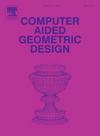2次样条曲线可以构造出什么样的光滑曲面?
IF 1.7
4区 计算机科学
Q3 COMPUTER SCIENCE, SOFTWARE ENGINEERING
引用次数: 0
摘要
在平面欧几里得域上,Powell-Sabin样条形成了一个总次为2的C1多项式的丰富空间,即二阶导数为常数的空间。然而,当由于曲面的格不为1而使该域具有不同的结构时,仅用总次二次多项式构建弯曲的自由曲面,并且每一块都定义在一个平坦的直边域三角形上,就会遇到阻碍。通过对这些障碍的精确定位,明确了二次曲面建模的局限性,对允许的C1自由形式结构进行了表征,并证明了它们必要的形状缺陷。本文章由计算机程序翻译,如有差异,请以英文原文为准。
What smooth surfaces can be constructed from total degree 2 splines?
On a planar Euclidean domain, Powell-Sabin splines form a rich space of polynomials of total degree 2, i.e. with constant second derivatives. However, when the domain has a different structure because the genus of the surface is not 1, building curved free-form surfaces solely with total degree quadratic polynomials, with each piece defined over a flat, straight-edge domain triangle, meets with obstructions. By pinpointing these obstructions, the limitations of modeling with quadratics are made precise, the allowable free-form constructions are characterized and their necessary shape-deficiency is demonstrated.
求助全文
通过发布文献求助,成功后即可免费获取论文全文。
去求助
来源期刊

Computer Aided Geometric Design
工程技术-计算机:软件工程
CiteScore
3.50
自引率
13.30%
发文量
57
审稿时长
60 days
期刊介绍:
The journal Computer Aided Geometric Design is for researchers, scholars, and software developers dealing with mathematical and computational methods for the description of geometric objects as they arise in areas ranging from CAD/CAM to robotics and scientific visualization. The journal publishes original research papers, survey papers and with quick editorial decisions short communications of at most 3 pages. The primary objects of interest are curves, surfaces, and volumes such as splines (NURBS), meshes, subdivision surfaces as well as algorithms to generate, analyze, and manipulate them. This journal will report on new developments in CAGD and its applications, including but not restricted to the following:
-Mathematical and Geometric Foundations-
Curve, Surface, and Volume generation-
CAGD applications in Numerical Analysis, Computational Geometry, Computer Graphics, or Computer Vision-
Industrial, medical, and scientific applications.
The aim is to collect and disseminate information on computer aided design in one journal. To provide the user community with methods and algorithms for representing curves and surfaces. To illustrate computer aided geometric design by means of interesting applications. To combine curve and surface methods with computer graphics. To explain scientific phenomena by means of computer graphics. To concentrate on the interaction between theory and application. To expose unsolved problems of the practice. To develop new methods in computer aided geometry.
 求助内容:
求助内容: 应助结果提醒方式:
应助结果提醒方式:


